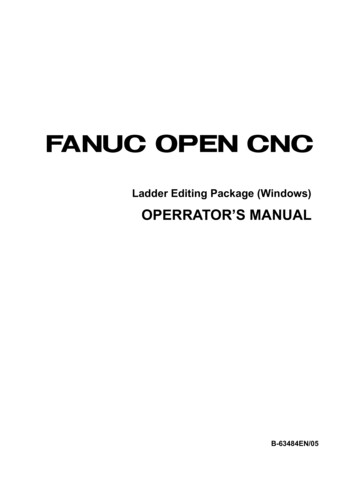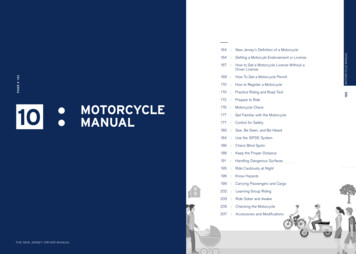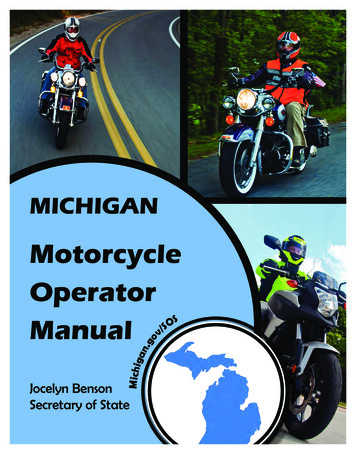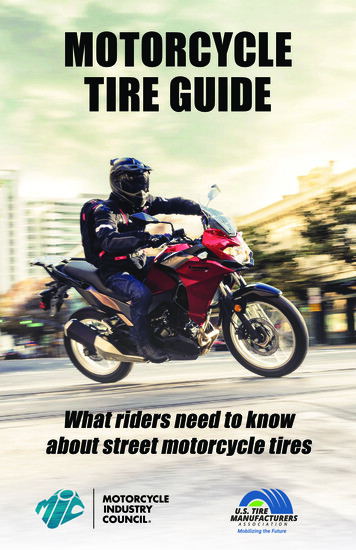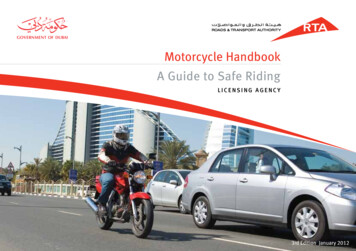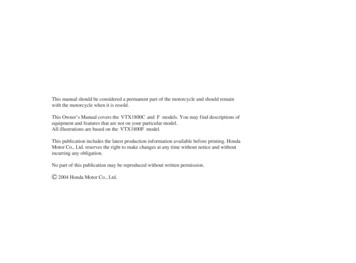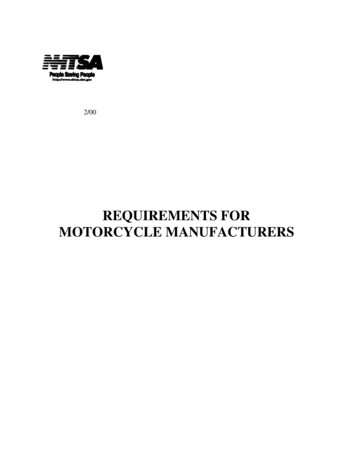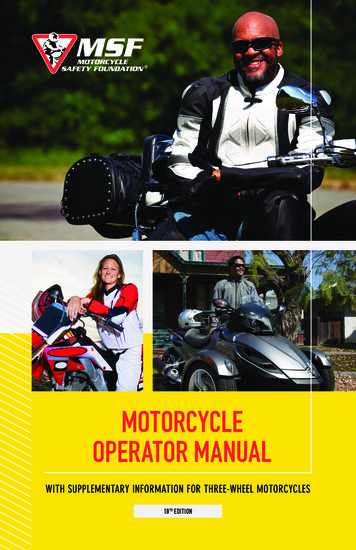
Transcription
MOTORCYCLEOPERATOR MANUALWITH SUPPLEMENTARY INFORMATION FOR THREE-WHEEL MOTORCYCLES18 TH EDITION
PREFACECONTENTS 1Riding a motorcycle is fun and can be a great means of transportation. But properskills and knowledge are needed to ride safely in traffic conditions.This 18th edition of the Motorcycle Safety Foundation Motorcycle OperatorManual* contains tips and strategies to help riders manage risk. The manual waswritten for novices and designed for use in licensing programs, but there’s greatinformation for all two- and three-wheel motorcycle riders. Topics covered includemotorcycle controls, developing effective street strategies, group riding, riding witha passenger, and more.Additional resources are available at MSF-USA.org, including the new MSFBasic eCourse, with interactive online exercises. But the best way to learn to rideis through formal hands-on training, like with the MSF Basic RiderCourse, whereyou’ll learn how to properly operate a motorcycle with the help of MSF-certifiedRiderCoaches.Making motorcycling safer, and as a result more fun, is our goal.Erik PritchardPresidentMotorcycle Safety Foundation*The original Motorcycle Operator Manual was developed by the National Public Services ResearchInstitute under contract to the National Highway Traffic Safety Administration as part of a cooperativeagreement between NHTSA and the MSF. Continuing to help state agencies with their licensing programs,the MSF offers the source files of this booklet to them at no charge. Write to MSF@MSF-USA.org for moreinformation.
2 CONTENTS THE RIDER ANDTHE MOTORCYCLE 3PREPARING TO RIDEBEING IN SHAPE TO RIDEWhy This Information IsImportant 40Wear the Right Gear 4Alcohol and Other Drugs inMotorcycle Operation 40Know Your Motorcycle 6Alcohol in the Body 40Know Your Responsibilities 9Alcohol and the Law 41RIDE WITHIN YOUR ABILITIESBasic Vehicle Control 10Minimize the Risks 42Step in to Protect Friends 42Keeping Your Distance 13Cannabis andMotorcycle Operation 43SEE 17Fatigue 43Intersections 19Increasing Conspicuity 22Crash Avoidance 25Handling Dangerous Surfaces 28Mechanical Problems 30EARNING YOUR LICENSE ORENDORSEMENT 44THREE-WHEEL SUPPLEMENTAnimals 32Supplementary Informationfor Three-Wheel Motorcycles 46Flying Objects 33Know Your Vehicle 46Getting Off the Road 33Basic Vehicle Control 48Carrying Passengersand Cargo 33Carrying Passengers and Cargo 51Group Riding 36HAND SIGNALS. 52T-CLOCS PRE-RIDE CHECKLIST 54
THERIDER AND THE MOTORCYCLE3RIDING ENVIRONMENTMotorcycling is a unique experience.Compared to a car, you don’t sit in amotorcycle, you become its upper half.Not as a passive driver, but as an activerider leaning into a string of smoothcorners, playing along with the rhythmof the road; shifting, accelerating, andbraking with precision. Whether youride to and from work or prefer thecamaraderie of a group ride on theweekend, motorcycling engages all yoursenses and creates an exhilarating senseof freedom.Along with that freedom comesresponsibility. All states require someform of license or endorsement todemonstrate you possess a minimumlevel of skill and knowledge. This bookletand other motorcycle publications canhelp prepare you to be successful. Youmight also consider taking a formalhands-on training course, even if yourstate doesn’t require that you completeone. You’ll learn how to improve yourriding skills and mental strategies, so youcan be a safer, more alert rider and enjoyriding that much more.The diagram above illustrates thecomplex environment that awaits you,and supports the concept that, as theMotorcycle Safety Foundation says, “Saferiding depends as much on the mentalskills of awareness and judgment as itdoes on the physical skill of maneuveringthe machine.”Successfully operating a motorcycle isa much more involved task than drivinga car. Motorcycling requires strength,coordination, and balance, as well asa heightened sense of awareness andposition amidst other roadway users. Amotorcycle is more responsive than acar, but is also more sensitive to outsideforces, like irregular road surfaces orcrosswinds. A motorcycle is also lessvisible than a car due to its narrowerprofile, and offers far less protection byexposing its rider to other traffic and theelements. All these risks can be managedthrough training and education.
4 PREPARING TO RIDEPREPARING TO RIDE 4What you do before you begin a ride goes a long way toward riding safelyand effectively. Before any ride, a safety-minded rider makes a point to:1. Wear the right gear.2. Become familiar with the motorcycle.3. Check the motorcycle parts and controls.WEAR THE RIGHT GEARWhen you ride, your gear is “right”if it protects you. In any crash, you havea far better chance of avoiding seriousinjury if you wear: A DOT-compliant helmet. Face or eye protection. Protective clothing.Helmet UseCrashes can occur — particularlyamong untrained, beginning riders.And one out of every five motorcyclecrashes results in head or neck injuries.Head injuries are just as severe as neckinjuries — and far more common. Crashanalyses show that head and neckinjuries account for a majority of seriousand fatal injuries to motorcyclists.Research also shows that, with fewexceptions, head and neck injuries arereduced by properly wearing a qualityhelmet.Some riders choose not to wear ahelmet. But, here are some facts toconsider: A DOT-compliant helmet lets yousee as far to the sides as necessary.Studies show that a helmet does notkeep a rider from spotting danger. Most crashes happen on short trips(less than five miles long), just a fewminutes after starting out. Most riders are riding slower than30 mph when a crash occurs. Atthese speeds, helmets can cut boththe number and the severity of headand neck injuries by half.No matter what the speed, helmetedriders are three times more likely tosurvive head injuries than those notwearing helmets at the time of thecrash. The single most important thingyou can do to improve your chances ifyou crash is to wear a securely fastened,quality helmet.Helmet SelectionRecommended are two primary typesof helmets, providing two differentlevels of coverage: three-quarter and fullface.Whichever style you choose, you canget the most protection by making surethat the helmet: Is designed to meet U.S. Department of Transportation (DOT)and state standards. Helmets witha label from the Snell MemorialFoundation also give you anassurance of quality. Fits snugly, all the way around. Has no obvious defects such ascracks, loose padding or frayedstraps.Whatever helmet you decide on, keepit securely fastened on your head whenyou ride. Otherwise, if you are involvedin a crash, it might fly off your head
5 CONTENTS 5before it gets a chance toprotect you.HELMETSEye and FaceProtectionA plastic impact-resistantfaceshield can help protectyour whole face in a crash.It also protects you fromwind, dust, dirt, rain, insectsand pebbles thrown upfrom cars ahead. Theseproblems are distractingand can be painful. If youhave to deal with them, youcan’t devote your full attention to theroad.Goggles protect your eyes, thoughthey won’t protect the rest of your facelike a faceshield does. A windshieldattached to the motorcycle is not asubstitute for a faceshield or goggles.Most windshields will not protectyour eyes from the wind. Neither willeyeglasses or sunglasses. Glasses won’tkeep your eyes from watering, andthey might blow off when you turnyour head while riding, or in windyconditions.To be effective, eye or faceshieldprotection must: Be free of scratches. Be resistant to penetration. Give a clear view to either side. Fasten securely, so it does not blowoff. Permit air to pass through, to reducefogging. Permit enough room for eyeglassesor sunglasses, if needed.Tinted eye protection should notbe worn when little outside light isavailable.ClothingThe right clothing protects you. It alsoprovides comfort as well as protectionfrom heat, cold, debris and hot andmoving parts of the motorcycle. It canalso make you more visible to others. Jacket and pants should cover armsand legs completely. They should fitsnugly enough to keep from flappingin the wind, yet loosely enough toallow you to move freely. Leatheroffers the most protection. Sturdysynthetic material provides a lot ofprotection as well. Wear a jacketeven in warm weather to preventdehydration. Many are designedto protect without getting youoverheated, even on summer days.Some riders choose jackets and pantswith “body armor” inserts in criticalbody areas for additional protection. Boots or shoes should be high andsturdy enough to cover your anklesand give them support. Soles shouldbe made of hard, durable, slipresistant material. Keep heels short sothey do not catch on rough surfaces.Tuck in laces so they won’t catch onyour motorcycle. Gloves allow a better grip and help
6 PREPARING TO RIDEprotect your hands. Your glovesshould be made of leather or similardurable material. Hearing protection reduces noisewhile allowing you to hear importantsounds such as car horns or sirens.Long term exposure to engine andwind noise can cause permanenthearing damage even if you wear afull face helmet. Whether you choosedisposable foam plugs or reusablecustom molded devices, be sureyou adhere to state laws regardinghearing protection.In cold or wet weather, your clothesshould keep you warm and dry, aswell as protect you from injury. Youcannot control a motorcycle well ifyou are numb. Riding for long periodsin cold weather can cause severe chilland fatigue. A winter jacket shouldresist wind and fit snugly at the neck,wrists and waist. Good-quality rainsuitsdesigned for motorcycle riding resisttearing apart or ballooning up at highspeeds.CLOTHINGKNOW YOURMOTORCYCLEThere are plenty of things on thehighway that can cause you trouble.Your motorcycle should not be oneof them. To make sure that yourmotorcycle won’t let you down: Start with the right motorcyclefor you. It should fit you well. Read the owner’s manual. Be familiar with the controls. Check the motorcycle beforeevery ride. Keep it in safe riding conditionbetween rides. Avoid add-ons and modificationsthat make it more difficult to handle.The Right Motorcycle For YouFirst, make sure your motorcycle isright for you. It should “fit” you. Yourfeet should reach the ground whileyou are seated on the motorcycle, andthe controls should be easy to operate.Smaller motorcycles are usually easierfor beginners to operate.At a minimum, your street-legalmotorcycle should have: Headlight, taillight and brakelight.TEST YOURSELF1A plastic shatter-resistant face shield:A. Is not necessary if you have awindshield.B. Only protects your eyes.C. Helps protect your whole face.D. Does not protect your face as well asgoggles.Answer - page 45
7 Front and rear brakes.of experience on their motorcycle. Turn signals.Get Familiar with theMotorcycle Controls Horn. Two mirrors.Borrowing and LendingBorrowers and lenders of motorcycles,beware. Crashes are more likely to occuramong beginning riders — especiallyin the first months of riding. Riding anunfamiliar motorcycle adds risk. If youborrow a motorcycle, get familiar withit away from traffic. And if you lendyour motorcycle to friends, make surethey are licensed and know how to ridebefore allowing them out into traffic.No matter how experienced youmay be, ride extra carefully on anymotorcycle that’s new or unfamiliarto you. More than half of all crashesinvolve riders with less than five monthsMake sure you are completely familiarwith the motorcycle before you takeit out on the street. Be sure to reviewthe owner’s manual. This is particularlyimportant if you are riding a borrowedmotorcycle.If you are going to use an unfamiliarmotorcycle: Check it out thoroughly. Find out where everything is, particularly the turn signals, horn,headlight switch, fuel-supply valveand engine cut-off switch. Find andoperate these items without havingto look for them. Know the controls. Work thethrottle, clutch lever, brakes,MOTORCYCLE CONTROLS
8 PREPARING TO RIDEand shifter a few times beforeyou start riding. Be very familiarwith the friction zone for manualtransmissions. Ride very cautiously and be awareof surroundings. Accelerate gently,take turns more slowly and leaveextra room for stopping.Check Your MotorcycleA motorcycle needs more frequentattention than a car. A minor technicalfailure on a car is seldom more than aninconvenience for the driver. The samefailure on a motorcycle may result in acrash or having to leave your motorcycleparked on the side of the road. Ifanything’s wrong with your motorcycle,you’ll want to find out about it beforeyou get in traffic.The primary source of informationabout how a motorcycle should beinspected and maintained is its owner’smanual. Be sure to absorb all of itsimportant information. A motorcyclewill continue to ride like new if it ismaintained and routine inspectionsbecome part of its maintenance.A pre-ride inspection only takesa few minutes and should be donebefore every ride to prevent problems.It’s quick and easy to check the criticalcomponents and it should be as routineand automatic as checking the weatherforecast before heading out for the day.A convenient reminder developed byMSF is T-CLOCSSM. There is a T-CLOCS“tear-out” sheet at the back of thismanual for you to keep. A T-CLOCSinspection should be conducted beforeevery ride, and includes checks of:T — Tires and Wheels Check tire inflation pressure,treadwear and general condition ofsidewalls and tread surface. Try the front and rear brake levers oneat a time. Make sure each feels firmand holds the motorcycle when fullyapplied.C — Controls Make sure the clutch and throttleoperate smoothly. The throttle shouldsnap back to fully closed whenreleased. The clutch should feel tightand should operate smoothly. Try the horn. Make sure it works.L — Lights and Electrics Check both headlight and taillight.Test the switch to make sure bothhigh and low beams work. Turn on both right and left handturn signals. Make sure all lights areworking properly. Try both brakes and make sure eachone turns on the brake light. Clean and adjust mirrors beforestarting. It’s difficult to ride with onehand while you try to adjust a mirror.Adjust each mirror so you can seethe lane behind and the lane nextto you. When properly adjusted, amirror may show the edge of yourarm or shoulder – but it’s the roadbehind you and to the side that areimportant.O — Oil and Other Fluids Check engine oil and transmissionfluid levels. Check the brake hydraulic fluid andcoolant level, if equipped, weekly. Be sure your fuel valve is open, ifequipped, before starting out. Withthe fuel valve closed, your motorcyclemay start with only the fuel that isstill in the lines, but will stall once thelines are empty. Look underneath the motorcycle forsigns of an oil or fuel leak.
C — Chassis Check the front suspension. Ensurethere is no binding. The rear shocksand springs should move smoothly. If there is a chain or belt, adjustaccording to the manufacturer’sspecifications, and check thesprockets for wear or damage.S — Stands Ensure the side stand operatessmoothly and that the spring holds ittightly in the up position. If equipped,the center stand should also be heldfirmly against the frame whenever themotorcycle is moving.Additionally, regular maintenancesuch as tune-ups and oil changes areimportant. Wear and tear is normalwith use; routine maintenance willhelp prevent costly breakdowns.The schedule for regular upkeepfor motorcycle parts and controls iscontained in the motorcycle’s owner’smanual.KNOW YOURRESPONSIBILITIES“Accident” implies an unforeseenevent that occurs without fault ornegligence. In traffic, that is not thecase. In fact, most people involved ina crash should probably claim someresponsibility for what takes place.Consider a situation where someonedecides to drive through an intersectionon a yellow light turning red. Yourlight turns green. You pull into theintersection without checking forpossible traffic. That is all it takes for thetwo of you to crash. It was the driver’sresponsibility to stop, and it was yourresponsibility to look before moving out.Someone else might be the first to startthe chain of events leading to a crash,9but it doesn’t leave any of us free of ourresponsibility to reduce risk.As a rider you can’t be sure that otheroperators will see you or yield the rightof way. To lessen your chances of acrash occurring: Be visible — wear proper clothing,use your headlight, ride in the bestlane position to see and be seen. Communicate your intentions —use the proper signals, brake lightand lane position. Maintain an adequate spacecushion — when following, beingfollowed, lane sharing, passing andbeing passed. Search your path of travel 12seconds ahead. Identify and separate hazards. Be prepared to act — remain alertand know how to carry out propercrash-avoidance skills, like firmbraking or swerving.Blame doesn’t matter when someoneis injured in a crash. The ability to rideaware, make critical decisions and carrythem out separates responsible ridersfrom the rest. Remember, it is up to youto keep from being the cause of, or anunprepared participant in, any crash.TEST YOURSELF2More than half of all crashes:A. Occur at speeds greater than 35mph.B. Happen at night.C. Are caused by worn tires.D. Involve riders who have less thanfive months of experience on theirmotorcycles.Answer - page 45
10 RIDE WITHIN YOUR ABILITIESReading this manual does not teach you the physicals skills to controldirection, speed or balance. That’s something you can learn only throughpractice, preferably in a formal course of instruction like an MSF RiderCourse.But control begins with knowing your abilities and riding within them, alongwith knowing and obeying the rules of the road.BASIC VEHICLE CONTROLBody PositionTo control a motorcycle well: Posture — Position yourselfcomfortably so you are able tooperate all the controls and steereffectively. This helps you interact wellwith your motorcycle and allows youto react quickly to hazards. Seat — Sit far enough forward sothat arms are slightly bent when youhold the handgrips. Bending yourarms permits you to press on thehandlebars without having to reachtoo far. Hands — Hold the handgripsfirmly to keep your grip over roughsurfaces. Start with your right wristflat. This will help you keep fromaccidentally using too much throttle.Also, adjust the handlebars so yourhands are even with or below yourHOLDING HANDGRIPSelbows. This permits you to use theproper muscles for proper steering. Knees — Keep your knees againstthe gas tank to help you keep yourbalance as the motorcycle turns. Feet — Keep your feet firmly on thefootrests to maintain balance. Don’tdrag your feet. If your foot catcheson something, you could be injuredand it could affect your control ofthe motorcycle. Keep your feet nearthe controls so you can get to themeasily if needed. Also, don’t let yourtoes point downward — they mayget caught between the road and thefootrests.Shifting GearsThere is more to shifting gears thansimply getting the motorcycle to pickup speed smoothly. Learning to use thegears when downshifting, turning orstarting on hills is equally important forsafe motorcycle operation.The gearshift lever is located in frontof the left footrest and is operated bythe left foot. To shift “up” to a highergear, position your foot under the shiftlever and lift and release. To downshift,press the shift lever down and release.The shift lever changes one geareach time it is lifted or pressed down.Whenever the lever is released, springloading returns it to center, where themechanism resets for the next shift upor down. A typical gear pattern is 1-N2-3-4-5. The N is for neutral, which isselected by either a “half lift” from 1stgear or a “half press” from 2nd gear.
Most motorcycles have five gears, butsome have four or six gears.As your motorcycle increasesspeed, you will need to shift up to ahigher gear. Shift up well before theengine RPM reaches its maximumrecommended speed. As a general rule,shift up soon enough to avoid overrevving the engine, but not so soon tocause the engine to lug.SHIFTING GEARS11slightly while smoothly easing out theclutch lever can help the engine comeup to speed more quickly and make thedownshift smoother. Shifting to a lowergear causes an effect similar to using thebrakes. This is known as engine braking.To use engine braking, shift down onegear at a time and ease out the clutchlever through the friction zone betweeneach downshift. Stay in the friction zoneuntil the engine speed stabilizes. Thenease out the lever fully until ready forthe next downshift. Usually you shiftgears one at a time, but it is possible toshift through more than one gear whilethe clutch lever is squeezed.Remain in first gear while you arestopped so that you can move outquickly if you need to.When upshifting, use a 3-stepprocess: 1) Roll off the throttle as yousqueeze the clutch lever, 2) lift theshift lever firmly as far as it will go andrelease, 3) smoothly ease out the clutchlever and adjust the throttle.You should shift down through thegears using the clutch lever as you slowor stop. You can also shift down whenyou need more power to accelerate.Make certain you are riding slowlyenough when you shift into a lowergear. If not, the motorcycle will lurch,and the rear wheel may skid. Whenriding downhill or shifting into first gearyou may need to use the brakes to slowsufficiently before downshifting safely.When downshifting, use a 3-stepprocess: 1) Roll off the throttle as yousqueeze the clutch lever, 2) press theshift lever down firmly and release, 3)ease out the clutch lever as you rollon the throttle. Rolling on the throttleWork toward a smooth, evenclutch lever release, especially whendownshifting. It is best to changegears before entering a turn. However,sometimes shifting while in the turnis necessary. If so, remember to do sosmoothly. A sudden change in power tothe rear wheel can cause a skid.BrakingImproper braking remains a significantcontributing factor in many motorcyclecrashes. Most motorcycles have twobrake controls: one for the front wheeland one for the rear wheel. Always useboth brakes every time you slow or stop.The front brake is more powerful andcan provide 70% or more of your totalstopping power. The front brake is safeto use if you use it properly.Maximum straight-line braking isaccomplished by fully applying bothfront and rear brakes without lockingeither wheel.To do this: Squeeze the front brake smoothly,
12 RIDE WITHIN YOUR ABILITIESfirmly and with progressively moreforce. Do not grab the brake lever oruse abrupt pressure. As the motorcycle’s weighttransfers forward, more tractionbecomes available at the front wheel,so the front brake can be appliedmore firmly after braking begins. Keep your knees against the tankand your eyes up, looking well ahead.This helps you stop the motorcycle ina straight line. Apply light-to-lighter pressureto the rear brake pedal to prevent arear wheel skid. As weight transfersforward less traction is available atthe rear.Using both brakes for even “normal”stops will permit you to develop theproper skill of using both brakesproperly in an emergency. Squeeze thefront brake and press down on the rear.Grabbing at the front brake or jammingdown on the rear can cause the brakesto lock, resulting in control problems.Braking in a CornerAny time a motorcycle is leaned over,the amount of traction available forbraking is reduced. The greater the leanangle, the more the possibility of thetires losing traction.To stop as quickly and as safely aspossible in a curve, and depending onroad and traffic conditions, try to get themotorcycle as perpendicular to the roadas possible, then brake. If conditions donot allow, brake smoothly and gradually,but do not apply as much braking forceas you would if the motorcycle werestraight up. As you slow, you can reduceyour lean angle, and as more tractionbecomes available for braking, you canmore firmly apply the brakes, so thatby the time the motorcycle is stopped,the motorcycle is straight up, and thehandlebars are squared. Doing this welltakes practice.Linked and IntegratedBraking SystemsSome motorcycles have linked brakingwhich connects the front and rearbrakes on the motorcycle and appliesbraking pressure to both brakes wheneither the front lever or rear pedal isapplied. An integrated braking systemis a variation of the linked system inwhich partial front braking is appliedwhenever the rear brake is activated.Consult the owner’s manual for adetailed explanation on the operationand effective use of these systems.Anti-Lock Braking Systems(ABS)ABS is designed to prevent wheellock-up and avoid skids when stoppingin panic situations. ABS operateswhen too much pressure is applied oneither the front or rear brake control. Ifelectronic sensors detect a possible wheellock, brake pressure is released thenreapplied to maintain maximum brakingeffectiveness if the brake controls remainapplied.ABS is capable of releasing andreapplying pressure more than 15 timesper second.TurningApproach turns and curves withcaution. Riders often try to take curvesor turns too fast. When they can’t holdthe turn, they end up crossing intoanother lane of traffic or going off theroad. Or, they overreact and brake toohard, causing a skid and loss of control.The following four steps will help youlearn to turn effectively. Note that inactual use these steps may overlap:
13 SLOW — Reduce speed before theturn by closing the throttle and, ifnecessary, applying both brakes.NORMAL TURNS LOOK — Look through the turn towhere you want to go. Turn just yourhead, not your shoulders, and keepyour eyes level with the horizon. PRESS — To turn, the motorcyclemust lean. To lean the motorcycle,press on the handgrip in the directionof the turn. Press left handgrip— lean left — go left. Press righthandgrip — lean right — go right.The higher the speed in a turn, or thesharper the turn, the greater the leanangle needs to be. ROLL — Roll on the throttle tomaintain or slightly increase speed.This helps stabilize the motorcycle.SLOW, TIGHT TURNSIn regular turns, the rider and themotorcycle should lean together at thesame angle.In slow, tight turns, counterbalance byleaning the motorcycle only and keepingyour body upright.KEEPING YOUR DISTANCEIt is good to have a “cushion ofspace” separating yourself from othervehicles on the roadway. This willprovide you with a clear view of trafficsituations, so that if someone elseTEST YOURSELF3makes a mistake, you will have:When riding, you should: More time to respond.A. Turn your head and shoulders to lookthrough turns. More space to maneuver, including anescape path if necessary.B. Keep your arms straight.Lane PositionsC. Keep your knees away from the gastank.D. Turn just your head and eyes to lookwhere you are going.Answer - page 45Successful motorcyclists know thatthey are safer when clearly seen byothers. In some ways the size of themotorcycle can work to your advantage.Each traffic lane gives a motorcycle
14 RIDE WITHIN YOUR ABILITIESthree paths of travel, as indicated in theillustration.Your lane choice should help you: Increase your ability to see and beseen. Avoid others’ blind spots. Avoid surface hazards. Communicate your intentions. Avoid windblast from other vehicles. Provide an escape path. Set up for turns.Many motorcyclists consider the leftthird of the lane – the left tire track ofautomobiles – to be their default laneposition. But consider varying your laneposition as conditions warrant, keepingin mind that no portion of the lane needbe avoided — including the center.You should position yourself in theportion of the lane where you are mostlikely to be seen and you can maintaina space cushion around you. Changeposition as traffic situations change.Ride in path 2 or 3 if vehicles and otherpotential problems are on your leftonly. Remain in path 1 or 2 if hazardsare on your right only. If vehicles arebeing operated on both sides of you,the center of the lane, path 2, is usuallyyour best option.Remember, the center third of thelane is the place where debris and oildrippings from cars collect and wherehazards such as surface covers arelocated. Unless the road is wet, thetypical center strip permits adequatetraction. You can operate to the leftor right of the grease strip and still bewithin the center third of the trafficlane. Avoid riding on big buildups ofoil and grease usually found at busyintersections or tollbooths.Experienced riders rely on their ownstrategies and judgment. One absolute,however, is to avoid riding in anothervehicle’s blind spot.Following Another Vehicle“Following too closely” is a frequentfactor in crashes involving motorcyclists.In traffic, motorcycles need as muchdistance to stop as cars. Normally, aminimum of two seconds distanceshould be maintained when following avehicle.To gauge your following distance:LANE POSITIONS
15FOLLOWING Pick out a mar
Riding a motorcycle is fun and can be a great means of transportation. But proper skills and knowledge are needed to ride safely in traffic conditions. This 18th edition of the Motorcycle Safety Foundation Motorcycle Operator Manual* contains tips
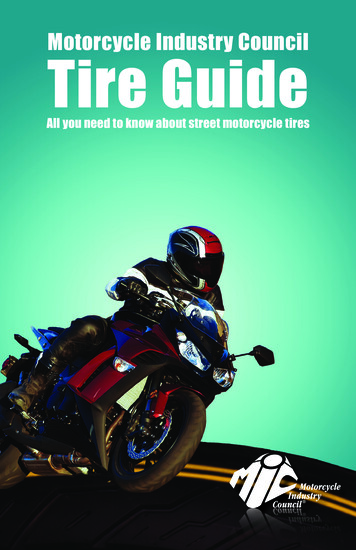
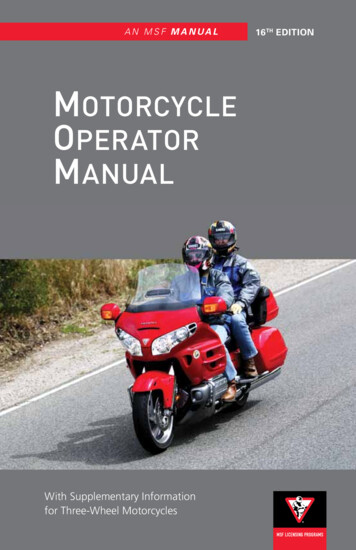
![Motorcycle Mechanic [MM] - CTEVT](/img/5/motorcycle-20-20mechanic-2010.jpg)

